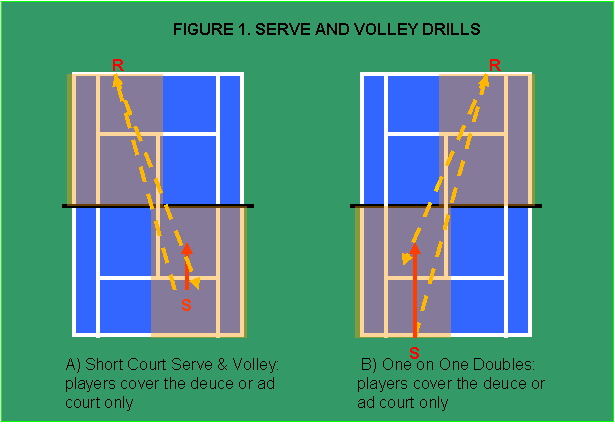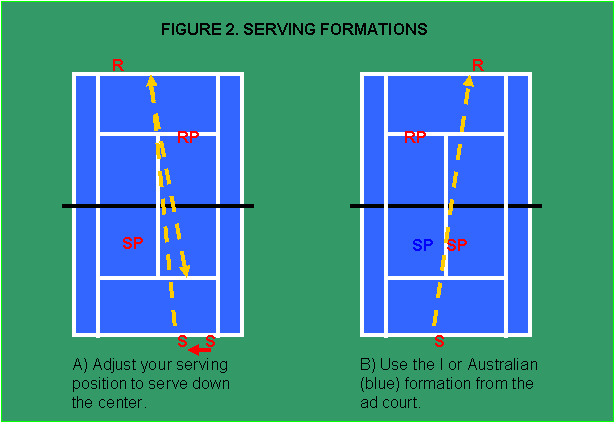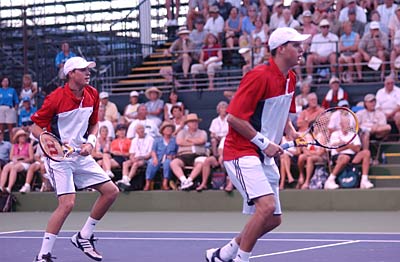|
TennisOne Lessons Tactical Lessons You Can Learn From WTA Doubles Doug Eng EdD, PhD In a couple recent articles, I made a quantitative analysis of what is happening in doubles on the WTA Tour. In this article, I summarize a few important tactical lessons that you can learn from the pros, even from their modern one-up and one-back formation. Let’s look at some lessons you can apply to your recreational or league tennis matches. Serve and Volley On the First Serve
On the first serve, a WTA pro won 56% of the points when she served and volleyed. She won only 41% of the first serve points if she stayed back. If you can make most of your volleys and have reasonable mobility, you should serve-and-volley on your first serve. Some players lose confidence in their volleys because they overweigh their errors and the fear of making errors deflates their confidence. It is quite normal that you will make more errors on volleys than groundstrokes. Sometimes, the errors scare us from going to the net. Nevertheless you should also make more winners or set up more forcing situations. The volley is a more decisive shot than a more neutral groundstroke so there will be more errors and more winners. Count the winners. Following are a couple drilling games (also shown in Figure 1) you can do to improve your serve and volley. Short Court Serve and Volley Game For less skilled volleyers, a good drill to try is serve and volley starting just behind the service line using only the deuce court or the ad court diagonal (including the doubles alley). That way you get comfortable and confident as you get into a dominant net position more easily. Then move back a few feet and continue serving and volleying. Finally move back to the baseline and practice serving and volleying using only the deuce or ad court. Keep score. One on One Doubles Game For more advanced players, you can play out serve-and-volley only using the deuce or ad court. This game is Ed Krass’s one-on-one doubles. It encourages serve-and-volley without using the full court. Practice playing a few games using only the deuce or ad court and doubles alleys. You and your opponent must serve and volley on the first (and second) serve. If you fail to go in and volley, you lose the point. Place Most Serves At the Center or Body When serving down the center (where the center line meets the service line), WTA pros won about 77% of the first serves. But when serving wide, the pros won only 56% of the first serves. At the body, the pros also won a few more points than serving wide. There were similar numbers for the second serve but not as dramatically different. Serving down the center makes it easier for the server’s partner to make a winning poach or volley. Angles are tougher to create for the receiver who usually has to place the ball through the center. To get more serves in the center, consider not standing halfway between the doubles line and the center hash mark. Stand a bit closer to the center to serve more accurately to the center (see Figure 2A). If your opponent has a dramatically weaker side, definitely go down the center if that shot is exposed in the center. However, if the clearly weaker side is in the alley, than you should serve wide. Whatever your service pattern, always vary it a little to keep your opponents off balance. Return Crosscourt In my previous study, the crosscourt return won about 48% of the points with the exception off the serve down the center which had a lower winning percentage. Otherwise, that’s a very good percentage for breaking serve. If you are late in returning crosscourt and often hit in the middle or at the net person, try one of these suggestions:
Be the First Team to Volley Regardless of your volley skills, if most of your volleys get back into the court, chances are you will have a higher winning percentage than when staying back. Consider this:
In addition, we already saw that the percentages for serve-and-volley were higher than serve-and-groundstroke. Overall, the team that volleys first wins most of the points. There are exceptions. On the second serve, often the return is better so when the server volleys, she won only about half the points. Set Up the Point and Poach On Your Stronger Volley In the previous study, the WTA pros hit twice as many winners than errors off the forehand volley but marginally more winners than errors off the backhand volley. This statistic might reveal some vulnerability on the two-handed volley. In any case, it still wins.
Consider which volley is stronger for you. You should take more chances on that volley including poaching. Your partner should be well aware of your strength and try to set you up with her serve. If your forehand volley is strong, then when your partner serves from the deuce court, you should consider poaching to the right more than usual. Your partner should place the serve (and get a high percentage of first serves in) to give you a better shot at poaching. Poach On the Crosscourt Rally Because the serve often is the biggest stroke in tennis, it sets up the server’s partner. However, among WTA pros, poaching during a rally is actually more common than poaching off a serve. The receiving team can also take the initiative by poaching after a strong return which David Brouwer calls the secondary poach. If the serve and return are well played and the server and receiver stay back, don’t be content to let the rally go on. Always look for poaching opportunities. As mentioned earlier, poaching on a rally won 65% of the points. If your partner hits a big groundstroke, she will give you excellent opportunities to make a successful poach. If you have a big forehand you can set up your partner by pounding your opponent’s weaker side. That often forces a weak or inaccurate reply that gives your partner excellent chances to win the point. Use the I and Australian Formations from the Ad Court
If you are a typical right-hander, using the I or Australian formation (see Figure 2B) from the ad court will induce more forehands and forehand volleys. If your forehand or forehand volley is better than your backhand, you will be in good shape. Although infrequently used, alternate formations won 65-70% of the rallies, whereas the regular formation wins under 60%. Stagger Your Formation at the Net Two at the net is not always a good idea. Often you are vulnerable to lobs or big groundstrokes. We saw that statistically two at the net only won about half of the points but one at the net and a second a bit farther back covers the court better. Between you and your partner, there may be one who closes in better and another who likes to have more time. Even the Bryan brothers like to get one player really on top of the net, the second player hangs farther back to cover more defensive shots.
Ideally a more defensive-minded, less aggressive player can stay back a bit around the service line to run down the lob. An aggressive player with excellent hands ideally stays on top of the net. Often my USTA women’s teams like this strategy. The older, more experienced volleyer often plays on top of the net and we may pair her up with a younger, quicker player who will cover behind the net player. Even my college men’s team use this tactical positioning. Try some of these tips to improve your doubles game. Play smarter and you'll enjoy your doubles more this summer! Your comments are welcome. Let us know what you think about Doug Eng's article by emailing us here at TennisOne.
Doug Eng EdD PhD coaches men's tennis at Tufts University. During the summer, he directs at the Tennis Camps at Harvard. He has received divisional Pro of the Year honors from the PTR and USPTA and several national award. Doug completed the USTA High Performance Coaches program and frequently runs educational and training programs for coaches. Doug also writes and speaks on tennis and sport science. |




